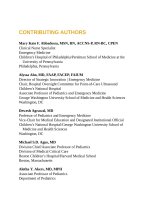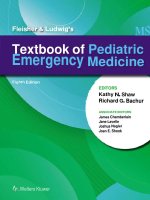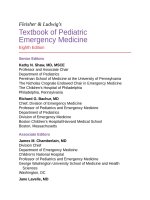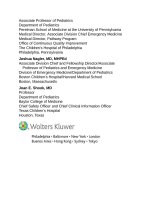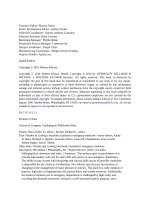Pediatric emergency medicine trisk 0210 0210
Bạn đang xem bản rút gọn của tài liệu. Xem và tải ngay bản đầy đủ của tài liệu tại đây (112.28 KB, 1 trang )
TABLE 9.5
CHEST COMPRESSION PARAMETERS
Previously, ED rescuers had little more than the presence of the femoral artery
pulse with compressions as a means of quickly assessing the adequacy of ECC.
Newer techniques such as ETCO2 monitors and accelerometer sensors allow for
the rapid and continuous monitoring of ECC quality. Specific ETCO2 values to
guide therapy have not been established in children. However, exhaled CO2 rises
as pulmonary blood flow and cardiac output increases; an ETCO2 of less than 10
mm Hg may indicate inadequate chest compression technique. Patients who have
return of spontaneous circulation (ROSC) often first demonstrate an abrupt
increase in ETCO2 to 35 mm Hg or greater. An accelerometer/force sensor
monitor provides real-time feedback of CPR quality. A sensor puck is placed on
the child’s chest and provides visual and verbal feedback about ECC quality.
Though previously only available for children >8 years old, new pediatric
electrodes with CPR rate and depth sensor capabilities are now available for
infants and children <8 years old.
In the newly arrested child, vigorous, high-quality chest compressions generate
approximately one-third of the normal cardiac output. This generates a coronary
artery perfusion pressure (CPP) of approximately 10 to 20 mm Hg. CPP
determines the blood flow to the myocardium and is equivalent to the difference
between the aortic pressure and the right atrial pressure. A minimum CPP of 5 to
10 mm Hg is needed to produce any myocardial blood flow. Increased CPP to
levels that allow for myocardial perfusion during CPR is associated with ROSC.
Pauses in CPR result in lower CPPs, supporting recent AHA efforts to minimize
interruptions in compressions during resuscitation.
The mechanism by which blood moves during CPR continues to be the subject
of investigation. Techniques that augment this forward flow could potentially
improve the rates of successful ROSC and neurologic survival. “Direct



